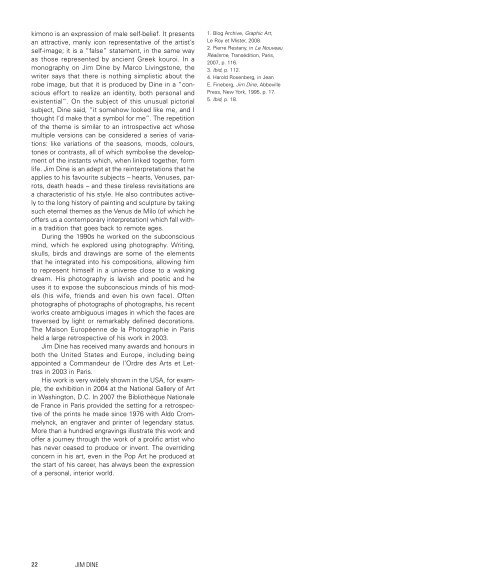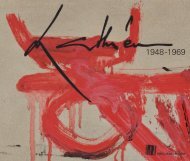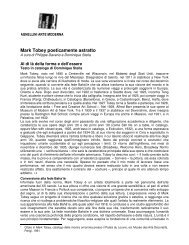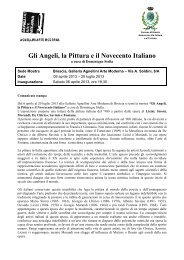Gabbia Bongiorno - Agnellini Arte Moderna
Gabbia Bongiorno - Agnellini Arte Moderna
Gabbia Bongiorno - Agnellini Arte Moderna
Create successful ePaper yourself
Turn your PDF publications into a flip-book with our unique Google optimized e-Paper software.
kimono is an expression of male self-belief. It presents<br />
an attractive, manly icon representative of the artist’s<br />
self-image; it is a “false” statement, in the same way<br />
as those represented by ancient Greek kouroi. In a<br />
monography on Jim Dine by Marco Livingstone, the<br />
writer says that there is nothing simplistic about the<br />
robe image, but that it is produced by Dine in a “conscious<br />
effort to realize an identity, both personal and<br />
existential”. On the subject of this unusual pictorial<br />
subject, Dine said, “it somehow looked like me, and I<br />
thought I’d make that a symbol for me”. The repetition<br />
of the theme is similar to an introspective act whose<br />
multiple versions can be considered a series of variations:<br />
like variations of the seasons, moods, colours,<br />
tones or contrasts, all of which symbolise the development<br />
of the instants which, when linked together, form<br />
life. Jim Dine is an adept at the reinterpretations that he<br />
applies to his favourite subjects – hearts, Venuses, parrots,<br />
death heads – and these tireless revisitations are<br />
a characteristic of his style. He also contributes actively<br />
to the long history of painting and sculpture by taking<br />
such eternal themes as the Venus de Milo (of which he<br />
offers us a contemporary interpretation) which fall within<br />
a tradition that goes back to remote ages.<br />
During the 1990s he worked on the subconscious<br />
mind, which he explored using photography. Writing,<br />
skulls, birds and drawings are some of the elements<br />
that he integrated into his compositions, allowing him<br />
to represent himself in a universe close to a waking<br />
dream. His photography is lavish and poetic and he<br />
uses it to expose the subconscious minds of his models<br />
(his wife, friends and even his own face). Often<br />
photographs of photographs of photographs, his recent<br />
works create ambiguous images in which the faces are<br />
traversed by light or remarkably defined decorations.<br />
The Maison Européenne de la Photographie in Paris<br />
held a large retrospective of his work in 2003.<br />
Jim Dine has received many awards and honours in<br />
both the United States and Europe, including being<br />
appointed a Commandeur de l’Ordre des Arts et Lettres<br />
in 2003 in Paris.<br />
His work is very widely shown in the USA, for example,<br />
the exhibition in 2004 at the National Gallery of Art<br />
in Washington, D.C. In 2007 the Bibliothèque Nationale<br />
de France in Paris provided the setting for a retrospective<br />
of the prints he made since 1976 with Aldo Crommelynck,<br />
an engraver and printer of legendary status.<br />
More than a hundred engravings illustrate this work and<br />
offer a journey through the work of a prolific artist who<br />
has never ceased to produce or invent. The overriding<br />
concern in his art, even in the Pop Art he produced at<br />
the start of his career, has always been the expression<br />
of a personal, interior world.<br />
1. Blog Archive, Graphic Art,<br />
Le Roy et Mister, 2008.<br />
2. Pierre Restany, in Le Nouveau<br />
Réalisme, Transédition, Paris,<br />
2007, p. 116.<br />
3. Ibid, p. 112.<br />
4. Harold Rosenberg, in Jean<br />
E. Fineberg, Jim Dine, Abbeville<br />
Press, New York, 1995, p. 17.<br />
5. Ibid, p. 18.<br />
22<br />
JIM DINE<br />
23












